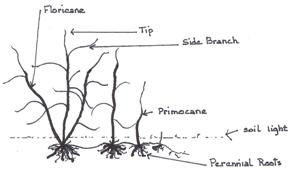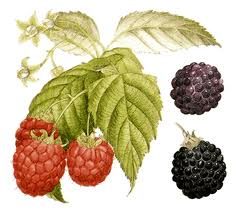|
|
Start In Spring For A Robust Crop Of Raspberries |
Raspberries Are Perennials Rather Than Shrubs. Like a Biannual, Each stem coming up from the perennial roots only lives for two years, then must be cut out. The first year the stem may not produce any fruit. The second year the stem bears fruit, then dies. New stems are emerging constantly from the perennial roots so that the plant lives on.
Planting Raspberries
- Choose a site in full sun.
- Plant in well drained soil. Sandy with organic matter is best. Avoid heavy clay as roots will rot.
- Raspberries like a soil of 5.6 to 6.2. You may need to add sulphur. Have your soil tested.
- Do not plant where tomatoes, potatoes, peppers or eggplant have grown in the last four years. These vegetables carry root rot Verticillium that is soil borne.
- Destroy all wild raspberries and blackberries within 600 feet if you can so that you do not catch diseases from the wild cousins.
Managing Raspberries
- Red Raspberries are the hardiest, followed by purple raspberries, black raspberries and blackberries.
- Crown and root of raspberries are perennial. Each stem lives only two years. The first year the cane has a green stem. If it is an everbearing, it will produce a light crop the first fall, but most raspberries don't. The second year the cane will produce fruit in summer. That cane will die after it has produced fruit, thus it is important for your pruning to be encouraging continued new growth.
 |
Black Raspberries. . . smaller, seedier and more aromatic berries and arching canes. Purple raspberries are a mix of red and black and act like black. Some varieties produce fruit in fall at top of first year cane, then again in summer the next year at the bottom of the same cane which is now a second year cane.
In March or Early April: Remove all small, weak canes. Leave 4 or 5 canes per clump. Cut back lateral (side) branches to 12 inches. When new shoots reach 36-48 inches tall, cut back 3 or 4 inches of the tips. This encourages lateral growth. Red Raspberries. . .more cold hardy, larger berries and more erect canes. Yellow raspberries grow like red raspberries. Most everbearing raspberries are red or yellow. In March or Early April: Remove weak, diseased or damaged canes. Leave vigorous canes that are 1/4 inch in diameter at 30 inches. Cut tips to live tissue. |
Fertilize Raspberries in Spring (March or April) and Fall (late October). Use Gardeners Special or, if you have a large patch use 10-10-10.
With proper care, Raspberries can last and produce well for 10 to 20 years. They will not last as long if neglected.
For more information visit
http://umaine.edu/publications/2066e/


